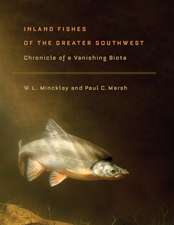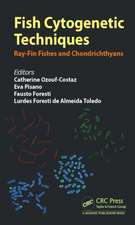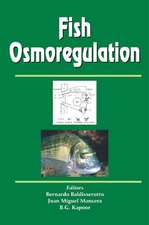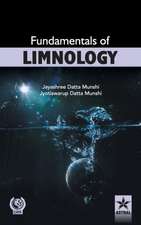Ecology and Conservation of Fishes
Autor Harold M. Tyusen Limba Engleză Hardback – 19 oct 2011
Major marine fisheries have collapsed, and there are worldwide declines in freshwater fish populations. Fishery scientists and managers must become more effective at understanding and dealing with resource issues. If not, fish species, communities, and entire ecosystems will continue to decline as habitats change and species are lost. Ecology and Conservation of Fishes has taken a historical and functional approach to explain how we got where we are, providing old and new with a better foundation as ecologists and conservationists, and most importantly, it awakens senses of purpose and need. Past management practices are reviewed, present programs considered, and the need for incorporating principles of applied ecology in future practices is emphasized.
Preț: 724.46 lei
Preț vechi: 883.48 lei
-18% Nou
Puncte Express: 1087
Preț estimativ în valută:
138.62€ • 144.73$ • 114.73£
138.62€ • 144.73$ • 114.73£
Carte tipărită la comandă
Livrare economică 04-18 aprilie
Preluare comenzi: 021 569.72.76
Specificații
ISBN-13: 9781439858547
ISBN-10: 1439858543
Pagini: 574
Ilustrații: 258 black & white illustrations, 141 colour illustrations, 26 black & white tables
Dimensiuni: 178 x 254 x 33 mm
Greutate: 1.13 kg
Ediția:1
Editura: CRC Press
Colecția CRC Press
ISBN-10: 1439858543
Pagini: 574
Ilustrații: 258 black & white illustrations, 141 colour illustrations, 26 black & white tables
Dimensiuni: 178 x 254 x 33 mm
Greutate: 1.13 kg
Ediția:1
Editura: CRC Press
Colecția CRC Press
Public țintă
Undergraduates and graduates, Ichthyologists, fishery scientists, ecologists, conservation biologists, zoologists, wildlife biologists, and professionals.Cuprins
Introduction: Ecology of Fishes: Content and Scope. Evolutionary Ecology of Fishes: Aquatic Evolution, Origins and Affinities. The Aquatic Environment. Fish Diversity: Chordates to Sharks. Teleostomes to Bony Fishes. Teleosts. Radiations and Extinctions. Freshwater Ecosystems: Zoogeography of Fishes. Lotic Systems: Flowing water and the terrestrial environment. Coldwater Streams. Warmwater Streams and Rivers. Lentic Systems: Standing Water. Fishes of Temperate and Tropical Great Lakes. Artificial Lakes and Groundwater Reservoirs. Estuarine and Marine Ecosystems: Estuaries. The Marine Environment, Intertidal Fishes, and Sharks. The Neritic Province and Fisheries. The Ocean Province and Epipelagic Fishes. Deep Sea: Twilight to the Abyss. Fish Adaptation: Fitness, Morphology and Ecophysiology. Energy, Metabolism and Growth. Adaptation, Niche, and Species Interactions. Populations, Growth, and Regulation. Instinct, Learning, and Social Behavior. Reproductive Ecology and Life History Patterns. Migration of Fishes. Larval Fish. Applied Ecology: The Human Factor: Exploitation, Conservation and Management. Crisis and a Response. Understanding the Decline. Changes and the Future.
Notă biografică
Harold M. Tyus is Emeritus Research Scientist at the Center for Limnology, Cooperative Institute for Research in Environmental Sciences, University of Colorado at Boulder, where he taught Ecology of Fishes in the Department of Ecology and Evolutionary Biology. He also is an Adjunct Professor of Environmental Policy and Management at the University of Denver, where he teaches and serves as a faculty advisor. Dr. Tyus received his academic training in the Department of Zoology at North Carolina State University, with the aid of a National Science Foundation fellowship and a scholarship from the National Wildlife Federation. He also was affiliated with the North Carolina Cooperative Fishery Unit, earning an MS studying sunfish phylogenetics and a Ph.D. studying population dynamics and migrations of river herring. His minor concentration was in water resources management.
Dr. Tyus is a retired researcher and manager for the U.S. Government, serving 23 years with the Army Corps of Engineers and Fish and Wildlife Service. During that time he was involved with environmental impact assessment and studied a wide variety of aquatic habitats, fishes, and human-induced changes in waters of the United States, from east coast oceans, estuaries and wetlands to southwestern desert rivers. He has written and edited numerous scientific papers on fishes and government documents on fish ecology and conservation, including listing and recovery plans for Endangered Species.
He was a member of the Colorado River Fishes Recovery Team for 12 years, and he has been a consultant and science advisor for industry and government. His professional affiliations include the Desert Fishes Council, the American Society of Ichthyologists and Herpetologists, and the Society for Conservation Biology. He is a Fellow of the American Institute of Fishery Research Biologists and a life member of the American Fisheries Society, which has certified him as a Fishery Scientist and Fisheries Professional.
Dr. Tyus is a retired researcher and manager for the U.S. Government, serving 23 years with the Army Corps of Engineers and Fish and Wildlife Service. During that time he was involved with environmental impact assessment and studied a wide variety of aquatic habitats, fishes, and human-induced changes in waters of the United States, from east coast oceans, estuaries and wetlands to southwestern desert rivers. He has written and edited numerous scientific papers on fishes and government documents on fish ecology and conservation, including listing and recovery plans for Endangered Species.
He was a member of the Colorado River Fishes Recovery Team for 12 years, and he has been a consultant and science advisor for industry and government. His professional affiliations include the Desert Fishes Council, the American Society of Ichthyologists and Herpetologists, and the Society for Conservation Biology. He is a Fellow of the American Institute of Fishery Research Biologists and a life member of the American Fisheries Society, which has certified him as a Fishery Scientist and Fisheries Professional.
Recenzii
"Overall, this volume offers a very good overview of issues that are now critically important in efforts to maintain both fisheries and the ecosystems that support them and in the efforts to maintain biodiversity. … the examples provided and the overall depth of coverage, along with the engaging writing style, combine to make this a very readable and informative book."
—Susan A. Foster and John A. Baker, Clark University, Worcester, Massachusetts, The Quarterly Review of Biology, Vol. 89, No. 1, 2014
"Tyus (emer., Univ. of Colorado at Boulder) attempts to better educate future fisheries managers and to infuse classic ecological concepts into modern fisheries management. ...The author writes in a clear, concise manner and includes case studies to illustrate real-world lessons learned. Because of the content, this book is more appropriate for upper-division or graduate-level courses. However, it could be used in a variety of courses, including environmental science, fish and fisheries science, biology, ecology, and ichthyology. Recommended."
—K. R. Thompson, Ozarks Technical Community College, in CHOICE, May 2012
"Overall, I find the approach to the subject very comprehensive and pedagogically user-friendly for introductory courses in Ecology and Conservation of Fishes. Dr. Tyus has brought his decades of experience to bear on this fine piece of work in a style that should appeal to students, instructors, and professionals."
—Emmanuel A. Frimpong, Ph.D., Assistant Professor, Department of Fisheries & Wildlife Sciences, Virginia Polytechnic Institute and State University
"The contents of a book do not always match the title of the book, but from what I read, this one does so magnificently. Dr. Tyus's early training in academia, his many years in active fisheries field research experiences, combined with his familiarity with the literature, followed by several successful years of teaching at the University of Colorado, Boulder, since his retirement from the U.S. Fish and Wildlife Service, make this book unique among other texts or references. Moreover, his organization of and within each chapter is excellent, providing for very interesting reading. The full color plates add great interest to this fine text/reference."
—Walter R. Courtenay, Jr., Ph.D., Professor Emeritus of Zoology, Department of Biological Sciences, Florida Atlantic University
"… has taken a historical and functional approach to explain how we got where we are, providing old and new with a better foundation as ecologists and conservationists, and most importantly, it awakens senses of purpose and need. Past management practices are reviewed, present programs considered, and the need for incorporating principles of applied ecology in future practices is emphasized. Includes a 16-page, full-color insert featuring 141 figures, as well as a glossary, a lexicon of Greek and Latin word roots, and an appendix on fish identification to help students master the text material."
—Northeastern Naturalist, December 2012
—Susan A. Foster and John A. Baker, Clark University, Worcester, Massachusetts, The Quarterly Review of Biology, Vol. 89, No. 1, 2014
"Tyus (emer., Univ. of Colorado at Boulder) attempts to better educate future fisheries managers and to infuse classic ecological concepts into modern fisheries management. ...The author writes in a clear, concise manner and includes case studies to illustrate real-world lessons learned. Because of the content, this book is more appropriate for upper-division or graduate-level courses. However, it could be used in a variety of courses, including environmental science, fish and fisheries science, biology, ecology, and ichthyology. Recommended."
—K. R. Thompson, Ozarks Technical Community College, in CHOICE, May 2012
"Overall, I find the approach to the subject very comprehensive and pedagogically user-friendly for introductory courses in Ecology and Conservation of Fishes. Dr. Tyus has brought his decades of experience to bear on this fine piece of work in a style that should appeal to students, instructors, and professionals."
—Emmanuel A. Frimpong, Ph.D., Assistant Professor, Department of Fisheries & Wildlife Sciences, Virginia Polytechnic Institute and State University
"The contents of a book do not always match the title of the book, but from what I read, this one does so magnificently. Dr. Tyus's early training in academia, his many years in active fisheries field research experiences, combined with his familiarity with the literature, followed by several successful years of teaching at the University of Colorado, Boulder, since his retirement from the U.S. Fish and Wildlife Service, make this book unique among other texts or references. Moreover, his organization of and within each chapter is excellent, providing for very interesting reading. The full color plates add great interest to this fine text/reference."
—Walter R. Courtenay, Jr., Ph.D., Professor Emeritus of Zoology, Department of Biological Sciences, Florida Atlantic University
"… has taken a historical and functional approach to explain how we got where we are, providing old and new with a better foundation as ecologists and conservationists, and most importantly, it awakens senses of purpose and need. Past management practices are reviewed, present programs considered, and the need for incorporating principles of applied ecology in future practices is emphasized. Includes a 16-page, full-color insert featuring 141 figures, as well as a glossary, a lexicon of Greek and Latin word roots, and an appendix on fish identification to help students master the text material."
—Northeastern Naturalist, December 2012
Descriere
Written as a stand-alone text for students, this book provides broad, comprehensive, and systematic coverage of all aquatic systems from the mountains to the ocean. It addresses freshwater, estuarine, and marine ecosystems in the first third of the book, and identifies factors that affect the distribution and abundance of fishes. It is followed with the examination of the adaptations of fishes as a response to constraints posed in ecosystems. The final four chapters on applied ecology discuss management, conservation, the biodiversity crises, and climate change. The book offers case studies from all major aquatic systems.













